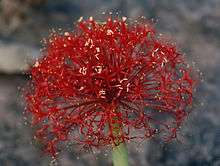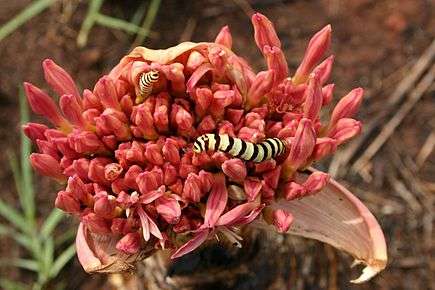Boophone
| Boophone | |
|---|---|
 | |
| Inflorescence of Boophone disticha | |
| Scientific classification | |
| Kingdom: | Plantae |
| Clade: | Angiosperms |
| Clade: | Monocots |
| Order: | Asparagales |
| Family: | Amaryllidaceae |
| Subfamily: | Amaryllidoideae |
| Genus: | Boophone Herb.[1] |
| Species | |
|
See text | |
| Synonyms | |

Boophone is a genus of herbaceous, perennial and bulbous plants in the Amaryllis family (Amaryllidaceae, subfamily Amaryllidoideae.[2]) It consists of two species distributed in tropical and southern Africa. It is closely related to Crossyne, a genus whose species have prostrate leaves.[3]
Taxonomy
Boophone is the single genus in subtribe Boophoninae, in the Amaryllideae tribe.
Phylogeny
Boophoninaeare placed within Amaryllideae as follow:
These are phylogenetically related as follows:
| Tribe Amaryllideae |
| ||||||||||||||||||
| |
Subdivision
The list of Boophone species, with their complete scientific name, authority, and geographic distribution is given below.[4]
- Boophone disticha (L.f.) [5] Distributed from Sudan to South Africa.
- Boophone haemanthoides Leight.[6] Distributed from Namibia to the Western Cape Province.
Etymology
William Herbert wrote the name of this genus with three different orthographies: "Boophane" in 1821; "Buphane" and Buphone" in 1825, and he conserved "Boophone" in 1837. Several authors since then speculated about the etymology and associated orthography of each name, but a proposal was published in 2001[7] to conserve the first name and to take the later ones as synonyms. This proposal was accepted in 2002.[8]
Associated insects
Larvae of the moth genera Brithys and Diaphone use Boophone as a food plant.
Traditional medicine
Boophone disticha is used in South African traditional medicine by the Zulus to induce hallucinations for divinatory purposes, and also for various mental illnesses.[9] Its use, however, is limited by injuries that result from the plant's toxicity.[10]
Chemistry
A variety of alkaloids with affinity for the serotonin transporter have been isolated from Boophone alkaloids.[11][12]
References
- ↑ Appendix: 18 (1821).
- ↑ Stevens, P.F. "Angiosperm Phylogeny Website: Asparagales: Amaryllidoideae"
- ↑ Vigneron, P. (2000–2006). "Boophone". Amaryllidaceae organization.
- ↑ Royal Botanical Gardens, Kew. World Checklist of Monocotyledons: Boophone . Accessed May 16, 2009.
- ↑ Herb. Bot. Mag. 52: t. 2578 (1825)
- ↑ Leighton, Frances Margaret. Journal of South African Botany 13: 59. 1947.
- ↑ R. H. Archer; R. K. Brummitt; D. A. Snijman (2001). "Proposal to conserve the name Boophone Herbert with that spelling (Amaryllidaceae)". Taxon. 50 (2): 569–572. doi:10.2307/1223904.
- ↑ Richard K. Brummitt. 2002. Report of the Committee for Spermatophyta: 53. Taxon, Vol. 51, No. 4 (Nov., 2002), pp. 795–799.
- ↑ Stafford GI, Pedersen ME, van Staden J, Jäger AK (2008). "Review on plants with CNS-effects used in traditional South African medicine against mental diseases". Journal of Ethnopharmacology. 119 (3): 513–37. doi:10.1016/j.jep.2008.08.010. PMID 18775771.
- ↑ J. F. Sobiecki (2002). "A preliminary inventory of plants used for psychoactive purposes in southern African healing traditions". Transactions of the Royal Society of South Africa. 57: 1–24. doi:10.1080/00359190209520523.
- ↑ Sandager M, Nielsen ND, Stafford GI, van Staden J, Jäger AK (2005). "Alkaloids from Boophane disticha with affinity to the serotonin transporter in rat brain". Journal of Ethnopharmacology. 98 (3): 367–70. doi:10.1016/j.jep.2005.01.037. PMID 15814274.
- ↑ Neergaard J, Andersen J, Pedersen ME, Stafford GI, van Staden J, Jäger AK (2009). "Alkaloids from Boophone disticha with affinity to the serotonin transporter". South African Journal of Botany. 72 (2): 371–4. doi:10.1016/j.sajb.2009.02.173.